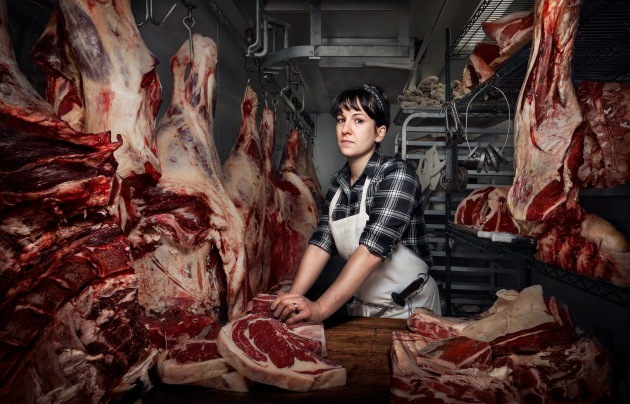Pros and their Secrets of Success
Almost every description of a great photographer leads with praise for their passion and talent. You could almost believe that these two attributes are the essence of success. If you did, you’d be pretty silly. Candide McDonald examines the inner resources that are actually essential.

Philadelphia, on 29 February 2016.
An amateur photographer needs passion in bucket loads. Without it, the hobby becomes a chore and the photo-buff wouldn’t do it. Passion drives an emerging photographer to finesse his or her craft. Passion for something, but not always photography, is the catalyst for the photographers that document wars, famine, endangered animals, and dying jungles. But on a commissioned job, a professional photographer needs to keep their passion in check. When they’re working with a brief, a budget, and what the client does and doesn’t like, problem solving needs to hold the reins. For a professional photographer, passion is something you call on if you need it. And often, you don’t.
So, now we come to talent. There are hundreds of thousands of talented people in every one of the creative arts. If success were just about talent, there would be hundreds of thousands of superstars. Talent is a great place to start, but it doesn’t run the show of success.
What does? Well, that’s where it gets interesting. It’s a combination of three things that anyone can cultivate – grit, guts, and gumption.

Grit
Grit isn’t the same as working hard. Grit is a quality within you. Its siblings are perseverance and resilience. In her book, Grit. The Power of Passion and Perseverance, Angela Duckworth references a poem by journalist, author, and MacArthur “Genius Grant” winner, Ta-Nehisi Coates that captures the essence of grit. It’s a poem about writing, but change one word in the first line and it’s a poem about photography.
The challenge of writing/ Is to see your horribleness on page./ To see your terribleness/ And then go to bed.
And wake up the next day,/ And take that horribleness and that terribleness,/ And refine it,/ And make it not so terrible and not so horrible./ And then to go to bed again.
And come the next day,/ And refine it a little bit more,/ And make it not so bad./ And then to go to bed the next day.
And do it again,/ And maybe make it average./ And then one more time,/ If you’re lucky, / Maybe you get to good.
And if you’ve done that,/ That’s a success.
Your “terribleness” might be in your work, in a pitch you lost, in a go-see that went nowhere, or in a job your client didn’t like so much. Grit is what you use when you know that the universe isn’t overseeing the lives of 7.2 billion people and isn’t going to make yours fabulous. When you’ve come to terms with the fact that life and careers aren’t fair. And when you stop running from this to that looking for that fast lane.

Guts
Guts has one rule. “If only” isn’t allowed. Guts’ siblings are determination and courage. Guts is “getting seriously f*cking organised”, as Lorraine Murphy notes in her book, Remarkability. It’s taking mistakes in your stride, she adds, not comparing yourself to anyone but you, being honest, even when something is painful to admit, doing rather than worrying about it, and using Plan B when Plan A doesn’t work.
Gumption
And gumption? According to the dictionary, it’s “shrewd or spirited initiative and resourcefulness”. Its siblings are confidence and positivity. It’s best described in an anecdote, so here’s one from my own life. Very early in my career, I was a journalist for Vogue (Australia). I’d been sent to cover a party for Rod Stewart with then emerging photographer, George Seper. Seper had already won a position as assistant to Vogue’s creative director and head photographer, Patrick Russell. He’d done this by turning up to an interview I did with the owner of Sydney’s top nightclub at the time, Arthur Karvan. He had made it his job to know Arthur because Arthur knew everyone, and made it his mission to be in the right place at the right time to show Russell his work.

The photo opportunity we’d been briefed on was Rod Stewart’s on-stage kiss with the current (at the time) Miss Australia. In the middle of that excitement, George said to me, “Go up there and kiss him now. I’ll make us famous.” So I did. And he did. I walked onto the stage and George captured a remarkable image - my face in profile, planting what appears to be a tender kiss on Rod Stewart’s cheek and Stewart’s face direct to camera, looking completely startled. I’m not saying that one carpe diem made Seper the hugely successful photographer he later became. I’m saying that gumption drove Seper like a Formula One racing car.
And then there’s presence
There is, in fact, one more quality with a role in success. It’s called presence, and it’s the love child of grit, guts, and gumption. It’s about communicating to others – in what you say, how you say it, and how you hold yourself in a situation – that you believe in yourself.
American social psychologist, author, and lecturer, Amy Cuddy has written a whole book on the subject. Here is its essence, in her words: “Presence stems from believing in and trusting yourself – your real, honest feelings, values, and abilities. That’s important, because if you don’t trust yourself, how can others trust you? Whether we are talking in front of two people or five thousand, interviewing for a job, negotiating for a raise, or pitching a business idea to potential investors, speaking up for ourselves or speaking up for someone else, we all face daunting moments that must be met with poise if we want to feel good about ourselves and make progress in our lives. Presence gives us the power to rise to these moments.”
Presence isn’t the same as arrogance or being an extrovert. Nor is it about trying to make a good impression. Its siblings are magnetism and amiability. Yes, amiability. People with presence are open, which draws people to them, and egalitarian, which (ironically) gives them power. Nor, though, is it the same as controlling. In no commercial job ever was one person given the role of a dictator, benevolent or otherwise. Presence makes people feel comfortable around you. And people want to do business with people who do that.

For advertising and portrait specialist Jonathan May, who has been ranked one of the Top 200 International Advertising photographers by Lürzer’s Archive for the past three years, it’s everything. “Belief. Belief in yourself, belief in your instincts, belief in your vision, belief in your direction, belief the work will come, and belief that you are making a difference,” he says, is the single most important attribute for success.
Of course, everyone describes these five keys to their success, or progression, in different terms.

Hallmarks of success
“Perseverance, desire and passion for your work, kindness, and grit (or thick skin),” are all in American photographer and journalist, Alex Potter’s inner arsenal. Potter works predominantly in the Middle East, her work exploring conflict and trust, loss and isolation within communities, and relationships.
Likewise for adventure sport and documentary photographer, Jody Macdonald, grit is her guiding light. “Perseverance. Never giving up. Basically, if you have grit and do good work, that is everything,” she says. “I think one thing that really helps me is my mentality towards adversity. I really try to embrace it when things go wrong or don’t go according to plan. I try very hard to view it as a learning opportunity and to be as resourceful as I can to get the job done,” she explains. “I often end up being more rewarded by the result. When things are going really wrong, I will take a moment, while the shit is hitting the fan to identify that this is really more of an opportunity to learn and focus on what I can do moving forward rather than what I can’t do. It’s a simple perception shift in my mind, but it changes everything.”

For May, who has representation in Australia, the USA, and Russia, grit translates into gratitude and positivity. “If you remain positive, it helps you persevere. I have experience from a previous life working in an office surrounded by people, and by nature we are social creatures, which can sometimes be tough as a photographer. There are often long hours, sometimes days writing treatments or editing images,” he explains. “Creative people often have an over-active mind and sometimes it’s easier to fall into negative mindset, especially when you miss out on a job to someone else. You need to remain positive and focus on yourself and the work will always come.”
Melbourne-based wedding photographer, Lucy Spartalis describes her grit like this: “Stubborn determination and an unending work ethic – two things that I didn't even realise I had before I went out on my own. Accepting that personal sacrifices were necessary to establish my business was hard. Saying ‘no’ to countless social invitations was painful at the time, but the rewards have made it worth it.”

Lifestyle and interiors photographer Armelle Habib relies on guts. “I am direct and transparent. No-one is left wondering what I think. But I am respectful and diplomatic, and work with good people.” Habib says that the market is full of great photographers. “It’s not enough just to shoot what you see. It’s about capturing the essence, the feeling, the heart and soul of the subject. That is not a technical skill alone. Working with clients that want you back means you are only as good as your last gig. So it’s a patience game. And being on your A game every day.”
Potter has gumption. The gumption to back herself. “For me, it took emptying my bank account multiple times to produce the type of work, and work on the types of stories, I cared about. No one was going to commission a new photographer to make work from Yemen, but I went back time and time again without assignment – because I cared about the people and the region. I don’t come from a family with money, nor do I have any investments,” she adds. “Be intentional, make connections, don't be afraid to reach out and just say ‘Hi’ to someone you want to meet – but also don't be offended if you never get an answer.”

Gumption enabled May to conquer the highly-paid world of advertising photography. “In the advertising world, you need to get good at writing treatments. This is the time to create trust with the art director and client,” he explains. “You might have the right style, but how well do you understand the brief and their brand, and can you deliver results?” When May was asked to write his first treatment for a brief, his gumption told him to do a test shoot. He then used its images in the treatment, and ended up winning the job. And it was quite a job. He was flown all around Australia shooting portraits for three weeks. “The agency said the test shoot was the deciding factor,” he says. “Be proactive. That half a day of my time secured a three-week payment, so you need to always put your best foot forward.”
Presence is too often overlooked by photographers and yet, when you ask, it is so often cited by editors, ad people, and other clients in the reasons they have hired photographers. American advertising photographer, Chris Crisman, who’s also been named in Lürzer's Archive 200 Best Photographers Worldwide, recognises presence as his single most important attribute, although he describes it in a complex of terms. “Approachability, thoughtfulness, humour, team spirit, fostering engagement with collaborators.” So, too, does Jonathan May. “You need to be someone that clients want to spend time with.” For May, presence is having the attributes you would look for in a good friend.” Spartalis believes that her “open, friendly, and somewhat daggy nature” is how her presence is expressed. For her, presence is “warmth, energy, humour, and compassion. Weddings are such highly emotionally-charged experiences for so many couples, so to assume that my relationship with them will be purely a professional one would be silly. It's truly an honour to be part of these incredible milestones in people’s lives, and even more so to spend so much of the day right by their side.”
Lastly, but perhaps, most importantly – not for how you get success, but whether you recognise it when it’s there – comes the inner quality of appreciation. Alex Potter explains: “You can be financially successful and make mediocre work that will never make an impact. You can make stunning work that's well known in the photo community, but goes no further. You can make a single image in your life that changes the world. You also can do none of these, and still be satisfied because you care about the work you’re doing for a specific project, or specific community, and have satisfaction in that. For my part, I'm still figuring out what success means, as I've dipped my toes into all of the above, but haven't been fully ‘successful’ in all my endeavours – and that’s OK.”

Contacts

Get more stories like this delivered
free to your inbox. Sign up here.

